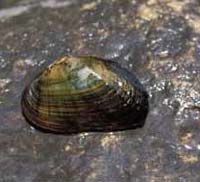Pearly Mussels: One of North America’s Natural Jewels is Disappearing

Eastern floater mussels are abundant in lakes and ponds throughout the Northeastern United States. The below illustration is from <i>The Pearly Mussels of the New York State</i>, written by David Strayer
If you have spent time boating or fishing in freshwater, there is a good chance you have encountered a pearly mussel. Elliptical in shape, with iridescent inner shells, humans have appreciated the animals since prehistoric times. Coveted for their pearls and mother-of-pearl shells; their meat has been a resource for both humans and wildlife. In a BioScience paper published this week, a team of scientists report that something troubling has been happening in our nation’s freshwaters— once-abundant pearly mussels are disappearing from the landscape.
Written by a team of seven mussel experts, the paper concludes that, “Many pearly mussel populations have a negative growth rate and are likely to disappear unless environmental conditions change.” To protect the animals, the authors urge simultaneous research and conservation actions, among them increased research on mussel biology and the protection of mussel habitat.
Though humans have been interacting with mussels for millennia, there are large gaps in our understanding of their life history and the role they play in freshwater ecosystems. Lead author Dr. David L. Strayer, a freshwater ecologist at the Institute of Ecosystem Studies, remarks, “Pearly mussels are imperiled by human activities, such as pollution, dam construction, and channelization. Dozens of species are already extinct and well over a hundred species are in danger of disappearing. For many mussel species, without intervention, future populations will be limited to specimens in museum drawers.”
Unique and highly specialized animals, mussels begin life as larvae before spending their adulthood as sedentary bivalves. Larvae, which are microscopic in size, parasitize a fish host before settling to the bottom of a freshwater ecosystem. Very specific in their choice of host, some mussels use elaborate lures to attract the correct fish species. In adulthood, pearly mussels act as filter feeders, eating plankton and other small particles of food suspended in the water.
Long-lived animals, most species live for decades. Currently, little is known about either mussel diets or the fascinating relationship between larvae and their fish hosts. As mussel beds decline in size, ecologists still don’t know the role that they play or what their absence might mean for the functioning of modern river ecosystems.
The loss of pearly mussels is especially troubling because, as long-lived aquatic organisms, they have the potential to reveal a world of information about the freshwater habitats they reside in. If we are to ensure mussels persist in the future, Dr. Strayer stresses, “We need to strengthen our understanding of their basic biology while minimizing human activities that have a known negative effect on populations. At the same time, we need to investigate how more subtle human activities, such as agriculture and suburbanization, impact freshwater systems.”
Media Contact
More Information:
http://www.ecostudies.org/press/pearly_mussels.htmlAll latest news from the category: Ecology, The Environment and Conservation
This complex theme deals primarily with interactions between organisms and the environmental factors that impact them, but to a greater extent between individual inanimate environmental factors.
innovations-report offers informative reports and articles on topics such as climate protection, landscape conservation, ecological systems, wildlife and nature parks and ecosystem efficiency and balance.
Newest articles

Peptides on Interstellar Ice
A research team led by Dr Serge Krasnokutski from the Astrophysics Laboratory at the Max Planck Institute for Astronomy at the University of Jena had already demonstrated that simple peptides…

A new look at the consequences of light pollution
GAME 2024 begins its experiments in eight countries. Can artificial light at night harm marine algae and impair their important functions for coastal ecosystems? This year’s project of the training…

Silicon Carbide Innovation Alliance to drive industrial-scale semiconductor work
Known for its ability to withstand extreme environments and high voltages, silicon carbide (SiC) is a semiconducting material made up of silicon and carbon atoms arranged into crystals that is…





















